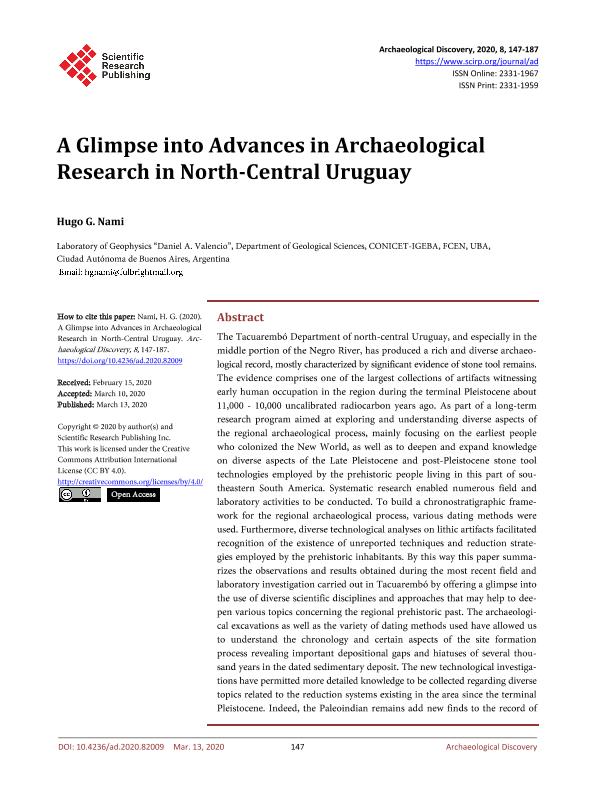Artículo
A Glimpse into Advances in Archaeological Research in North-Central Uruguay
Fecha de publicación:
04/2020
Editorial:
Scientific Research Publishing
Revista:
Archaeological Discovery
ISSN:
2331-1959
e-ISSN:
2331-1967
Idioma:
Inglés
Tipo de recurso:
Artículo publicado
Clasificación temática:
Resumen
The Tacuarembó Department of north-central Uruguay, and especially in the middle portion of the Negro River, has produced a rich and diverse archaeological record, mostly characterized by significant evidence of stone tool remains. The evidence comprises one of the largest collections of artifacts witnessing early human occupation in the region during the terminal Pleistocene about 11,000 - 10,000 uncalibrated radiocarbon years ago. As part of a long-term research program aimed at exploring and understanding diverse aspects of the regional archaeological process, mainly focusing on the earliest people who colonized the New World, as well as to deepen and expand knowledge on diverse aspects of the Late Pleistocene and post-Pleistocene stone tool technologies employed by the prehistoric people living in this part of southeastern South America. Systematic research enabled numerous field and laboratory activities to be conducted. To build a chronostratigraphic framework for the regional archaeological process, various dating methods were used. Furthermore, diverse technological analyses on lithic artifacts facilitated recognition of the existence of unreported techniques and reduction strategies employed by the prehistoric inhabitants. By this way this paper summarizes the observations and results obtained during the most recent field and laboratory investigation carried out in Tacuarembó by offering a glimpse into the use of diverse scientific disciplines and approaches that may help to deepen various topics concerning the regional prehistoric past. The archaeological excavations as well as the variety of dating methods used have allowed us to understand the chronology and certain aspects of the site formation process revealing important depositional gaps and hiatuses of several thousand years in the dated sedimentary deposit. The new technological investigations have permitted more detailed knowledge to be collected regarding diverse topics related to the reduction systems existing in the area since the terminal Pleistocene. Indeed, the Paleoindian remains add new finds to the record of the early colonizers living in Tacuarembó during the last millennium of the Pleistocene. Also, the identification of clear turtle-back Levallois-like cores agrees with earlier finds in other locations in southeastern South America and yielded excellent examples of the employment of the flaking strategy by the prehistoric populations living in Tacuarembó. From the experimental lithic technology perspective, modern reproductions of the stone tools afforded an understanding of various aspects of the reduction sequences and technical features of their analogs from the past.
Archivos asociados
Licencia
Identificadores
Colecciones
Articulos(IGEBA)
Articulos de INSTITUTO DE GEOCIENCIAS BASICAS, APLICADAS Y AMBIENTALES DE BS. AS
Articulos de INSTITUTO DE GEOCIENCIAS BASICAS, APLICADAS Y AMBIENTALES DE BS. AS
Citación
Nami, Hugo Gabriel; A Glimpse into Advances in Archaeological Research in North-Central Uruguay; Scientific Research Publishing; Archaeological Discovery; 8; 2; 4-2020; 147-187
Compartir
Altmétricas




